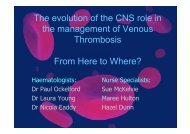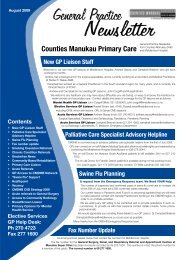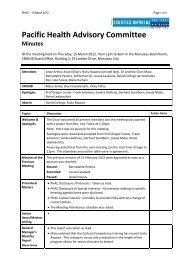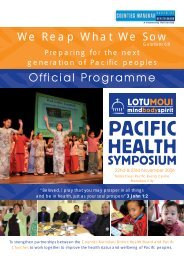Minutes of CMDHB Clinical Advisory Group (CAG) - Counties ...
Minutes of CMDHB Clinical Advisory Group (CAG) - Counties ...
Minutes of CMDHB Clinical Advisory Group (CAG) - Counties ...
You also want an ePaper? Increase the reach of your titles
YUMPU automatically turns print PDFs into web optimized ePapers that Google loves.
<strong>Clinical</strong> <strong>Advisory</strong> <strong>Group</strong> (<strong>CAG</strong>)<br />
<strong>Minutes</strong><br />
Of the meeting held on Wednesday, 17 th November, 2010 Meeting Rooms 1&2, 19 Lambie Drive at<br />
1800 - 1930 hrs<br />
Agenda Item ACTION<br />
Present<br />
Peter Gow (Chair), Allan M<strong>of</strong>fitt, Michael Clark, John Roke, Soli Henare,<br />
David Hughes, Analosa Ulugia-Veukiso, Campbell Brebner, John Savory,<br />
Martin Chadwick, Sam Cliffe, Karyn Sangster, Jenni Coles, Gary Jackson<br />
In Attendance<br />
Apologies<br />
1. <strong>Minutes</strong> <strong>of</strong><br />
Oct Meeting<br />
Action Plan Update<br />
2. POAC<br />
Campbell Brebner<br />
3.<br />
Crossing the<br />
Chasm in four<br />
leaps: A call for a<br />
health plan<br />
Ko Awatea<br />
Geraint Martin,<br />
Jonathon Gray<br />
Crossing a Chasm in<br />
Four Leaps<br />
Val McCullough, Tanya Maloney, Tina McCafferty, Sue Hallwright, Kris<br />
Vette, Andrew Stacey, Geraint Martin, Jonathan Gray, Marlene Van<br />
Hooven, Bernard Te Paa<br />
Don Mackie, Denise Kivell, Nua Tupai, Penny Impey<br />
Passed as true record.<br />
Pharmacists Access to HbA1C Results via TestSafe Repository<br />
The agreement was yes we will open up HbA1C but when we start moving<br />
towards clinical documents, EDSs etc being available more consultation<br />
will be undertaken with the community seeking feedback on<br />
appropriateness re the acceptance <strong>of</strong> clinical documents being available<br />
wider than simply primary care itself. Looking at clinical documents going<br />
on TestSafe approximately the middle to end <strong>of</strong> 2011.<br />
� POAC Maori utilisation not as high as would have liked<br />
� Completed some analysis which is hoped will reassure us to some<br />
extent and might make us rethink whether the indicator used on the<br />
dash board is appropriate or needs rethinking<br />
� 21% <strong>of</strong> POAC patients under 5s are Maori<br />
� 22% <strong>of</strong> <strong>CMDHB</strong> under 5s are Maori<br />
� 5-15 age group tracking close but gap increase as age increases.<br />
� Quite a dramatic number <strong>of</strong> older people using POAC<br />
� POAC figures as compared to ASH figures indicate we are lagging<br />
behind for Maori. Looking at developing an alternative group <strong>of</strong> ICD 10<br />
codes that better reflect what POAC can do. Hopefully when we reanalyse<br />
the data using these codes the areas will come together<br />
� Utilisation rates per 1000 patients over 5 years - there were 424 Maori<br />
under 5 POAC patients in 5 years and 8536 Maoris under 5 so<br />
utilisation per 1000 is just under 50. Utilisation for other (European,<br />
Asian etc) is lower than 40. Utilisation rates for Maori are high except<br />
for this age group.<br />
Key Points<br />
� Manukau a City <strong>of</strong> the Future - will reach the size <strong>of</strong> Hamilton<br />
� Designing the future is a positive not a passive act : hope is not a plan<br />
� One size will not fit all, but one method will<br />
� Peripheral changes will not deliver<br />
� We must change the game radically to succeed: Ko Awatea a place<br />
where we can bring together the best international thought, the best <strong>of</strong><br />
our own practice and our own incredibly creative minds to find solutions<br />
to the problems we are facing in quality improvement, population<br />
health, in clinical leadership and workforce development and innovation<br />
and how we deal with health inequalities. It is a place where we need to<br />
come to synthesise the best knowledge with the best practice to ensure<br />
we have the best outcomes
Agenda Item ACTION<br />
Raising the standard<br />
� We need to develop a compelling vision and delivery plan<br />
� We need a standard to rally around<br />
- We will not change our behaviours, let alone the system<br />
- Tragedy <strong>of</strong> the Commons and Easter Island<br />
- Nothing by which to align, to practice by values, to build capacity<br />
or to lever change by<br />
� Faced with a compelling case to mobilise for change we need to<br />
become Manchester United not our current best which is like watching<br />
kids play soccer in the park<br />
A Vision<br />
� Moving the Sector to be clear on what it is aiming to do and where our<br />
focus is on the value we add<br />
- Value = Cost+quality+effective design<br />
Robert H Brook. The end <strong>of</strong> the quality improvement movement: Long live improving<br />
value. JAMA. 2010;304(16):1831-1832<br />
- The “Big Dots” : “to move the needle”<br />
- Role <strong>of</strong> the DHBs as a system integrator<br />
- Both best and new practice<br />
- Build capacity and methodology : The need for a Brain<br />
Using the campaign methodology<br />
Adding Value to the health & lives <strong>of</strong> 1.6m New Zealanders<br />
- Quality & Efficiency: First do no harm<br />
- Redesigning the system : Adding life to years<br />
- Reducing demand thru’ prevention: Adding years to life<br />
- Shared decision making: Patient & family centred care<br />
What are the Big Dot Interventions to make these things happen?<br />
Campaign 1 : First do no harm<br />
Aim : By 2015 we will be the safest healthcare system in Australasia<br />
� There are clear evidence based interventions which if systematically<br />
applied will<br />
- Save an additional 500 lives annually<br />
- Prevent 25,000 episodes <strong>of</strong> harm<br />
- Save money and free up capacity<br />
- Improve productivity<br />
Campaign 2 : Adding life to years<br />
Aim : By 2015 we will add x years <strong>of</strong> productive life to the people <strong>of</strong><br />
the Northern region<br />
� This will be achieved by focussing on five conditions which if “best<br />
designed” would deliver a significant improvement to the health <strong>of</strong> the<br />
population, keeping citizens productive and learning and reducing<br />
demand for hospital services<br />
- Childhood mortality and morbidity<br />
- COPD/Asthma<br />
- CVD<br />
- Frail Elderly<br />
- Diabetes<br />
� By delivering this we would also deliver the BSMC Business Cases<br />
Campaign 3 : Adding years to life<br />
Aim : By 2020 to increase y years <strong>of</strong> life in the Northern region by :<br />
� Reducing the risk <strong>of</strong> diabetes by removing 1 million (m) kg <strong>of</strong> fat from<br />
the Northern region by 2015<br />
� Reducing the number <strong>of</strong> cigarettes smoked by 1m by 2015<br />
� Reducing the number <strong>of</strong> alcohol related injuries by 50%<br />
Campaign 4 : Shared Decision Making
Agenda Item ACTION<br />
Aim : By 2015 to reduce demand by z for marginal treatment<br />
decisions by involving patients in decision making<br />
� International evidence in a range <strong>of</strong> elective areas<br />
� Platform for health literacy : training the expert patient<br />
� Patient and Family/Whanau Centred Care<br />
� End <strong>of</strong> life care<br />
How would we intervene<br />
� Condition<br />
� Describe existing system<br />
- Cost<br />
- Volume<br />
- Outcome<br />
� Clinicians to review<br />
� Best practice, technical efficiency, reduce variation, marginal (dis)<br />
investment<br />
� Quantify the outcome<br />
� Intervention design<br />
� Evaluate delivery<br />
Strategic<br />
Partners<br />
- Academic<br />
Board<br />
- IHI<br />
- Oxford Centre<br />
- Dartmouth<br />
- Jönköping<br />
DHB<br />
STRATEGY<br />
Ko<br />
Awatea<br />
- Centre for Quality<br />
- Centre for Workforce<br />
Development<br />
- Centre for Innovation &<br />
Research<br />
- Centre for <strong>Clinical</strong> Leadership<br />
- Centre for Health Intelligence<br />
- Method<br />
- Capacity<br />
- Evidence<br />
- Evaluation<br />
- Innovation<br />
- Dissemination<br />
System<br />
Improvement<br />
<strong>Clinical</strong><br />
Faculty<br />
Local<br />
Capacity<br />
Annual<br />
Performance<br />
Innovation<br />
“Activated Network”<br />
Culturum – people, system and network, leadership, culture change<br />
“Pipeline”<br />
Knowledge management, evidence/R&D pipeline, communications<br />
“Methodology for Change”<br />
Expert resource, QI, measurement, workforce and nurse development<br />
“Learning”<br />
Futurum - evaluation and joint research/PHDs<br />
How do we have the place at the middle <strong>of</strong> this to solve the challenges and<br />
lead change?<br />
Discussion<br />
� Forum being described has similarities in parts to the former <strong>Clinical</strong><br />
Board being a focus group <strong>of</strong> clinical leadership and management<br />
bought together to problem solve but got bogged down in procedures,<br />
policy etc. Challenge to try and capture and keep going.
Agenda Item ACTION<br />
� We don’t have an accurate snapshot <strong>of</strong> where we are now and truly<br />
analyse what we do before we embark on how to plan the future. We<br />
constantly fail to capture the good we are achieving and we don’t put a<br />
well costed look at where the gap is and what the failings are before we<br />
decide to move to the next step<br />
� Easy in health to think that solutions come in evidence based medicine<br />
but reality is this is all very well in a controlled environment but actually<br />
when you interface with the community there are diverse ways <strong>of</strong><br />
interacting with the medical pr<strong>of</strong>ession and health care in general and<br />
we need to learn about what works for them and adapt everything for<br />
what is real for them<br />
� Act local drive national<br />
� Imagine, then plan, then deliver. Action comes from the arrows not the<br />
boxes. Flow comes from the in between bits<br />
� Picture has to be changeable. As you transition through, it is all about<br />
relationships<br />
� Importance <strong>of</strong> operational management important here. Can have great<br />
ideas but need a skilled manager to implement them<br />
� From a regional perspective our space is hugely pregnant with<br />
potential. We need to create capacity that can be used elsewhere<br />
� From the Maori perspective we need to capture innovative play makers<br />
amongst us. We are good at doing things for our community but we<br />
need to do things with our community. We need to maintain local focus,<br />
get representation right, more health equity talks taking place, or else<br />
we miss local wins<br />
� From a Community Panel (CP) perspective in terms <strong>of</strong> Ko Awatea when<br />
we live in <strong>Counties</strong> Manukau (CM) we don’t just use CM services.<br />
Resource needs to be shared regionally. Lot <strong>of</strong> focus on clinical<br />
improvement but where do the community and other players fit in?<br />
� From a CP perspective how does patient and family centred care look?<br />
The CP have a slogan “nothing about us without us”. How can we work<br />
along managers and clinicians to effect change? Change requires<br />
relationships<br />
� Change methodology needs thinking about. How will Ko Awatea make<br />
change happen? Need to get involved in community, and primary care<br />
� If Ko Awatea becomes hospital based then becomes a failure<br />
� Need to be looking at big dot, whole system indicators which will ensure<br />
we focus on the right interventions to drive the solutions<br />
� From a Pharmaceutical point <strong>of</strong> view community pharmacists are under<br />
utilised in the workforce. The remuneration structure partly contributes<br />
to that. The only thing you can quantify in a pharmacists day is the<br />
number <strong>of</strong> prescriptions they do. There are a lot <strong>of</strong> Brief Opportunistic<br />
Interventions (BOIs) which includes advising patients, referring patients<br />
to medical clinics etc. There are a number <strong>of</strong> Pharmacists who would<br />
be keen to pick up more clinical coverage. Pharmacists get the<br />
impression they are regarded as an expendable cost centre rather than<br />
a benefit centre. This is a hurdle that needs to be overcome.<br />
� Need to remove waste - <strong>of</strong> duplication <strong>of</strong> processes. duplication <strong>of</strong><br />
effort, lack <strong>of</strong> defined positions etc<br />
� Need to decide who is going to drive and co-ordinate things to take<br />
things forward<br />
To reflect:<br />
Jonathan is amazed by positive, energetic response to challenge. Has<br />
been a motivating response.<br />
Geraint - where to next? Nothing set in concrete yet. Need people built in<br />
to effect change – joint exercise. To achieve the things we are talking about<br />
we need to galvanise getting things right. Need to capture hearts and<br />
minds. We CAN DO THIS right across the system. We can be engaged in a<br />
positive revolution in health care. We can make the future a better more<br />
effective place.
Agenda Item ACTION<br />
4. Community<br />
Panel Update<br />
Soli Henare /<br />
Anaolosa Ulugia-<br />
Veukiso<br />
Think over the next month how we can engage the wider group and at the<br />
December meeting combined with the Community Panel we can discuss<br />
the how.<br />
Community Panel topic for discussion<br />
The topic decided by the Community Panel for discussion at <strong>CAG</strong>'s end <strong>of</strong><br />
year meeting is, 'Better, Sooner, More Convenient', with the following<br />
questions posed by the Community Panel:<br />
• Does the community have a place in BSMC?<br />
• What is the place <strong>of</strong> the community in BSMC?<br />
• What plans have been developed by PHO's and DHB's for public<br />
consultation and communication <strong>of</strong> BSMC?<br />
Community Panel representative on <strong>CAG</strong><br />
Analosa Ulugia-Veukiso was nominated to be the Community Panel<br />
representative. She recently resigned from the Community Panel due to<br />
other commitments, effective at the end <strong>of</strong> 2010. Paula Nes in conjunction<br />
with the Chair <strong>of</strong> the Community Panel and the Community Liaison<br />
Manager will re-convene to discuss the process for representation in 2011.<br />
5. General<br />
Business<br />
Next Meeting 15 th December from 6pm to 7.30pm �In Meeting Rooms 1& 2 � <strong>Counties</strong><br />
Manukau DHB, 19 Lambie Drive, Manukau
ACTIONS REQUIRED SHEET<br />
WHO WHAT BY WHEN<br />
Gary Jackson<br />
Val<br />
Val<br />
McCullough<br />
Dashboards<br />
Action Point:<br />
Recommend look at receiving report<br />
monthly and spend significant part <strong>of</strong><br />
agenda on this 3 monthly<br />
Action Point :Invite Aaron Jackson to talk<br />
about the Medicines Reconciliation<br />
project<br />
February, May,<br />
August, November<br />
November<br />
Invite sent







